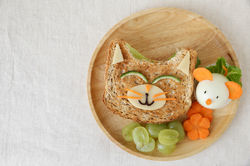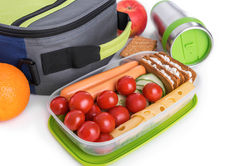Good Food + Active Bodies Prepares Students for Success
As a teacher, I see students who arrive at school refreshed and ready to get to work. And then there are some who look tired and struggle to stay focused. Research has shown that well-nourished children are more focused and able to learn in class. Poorly nourished children generally perform weaker academically and get worse results on standardized tests. Many children in the United States fail to eat a balanced and nutritious diet. In some cases, students arrive at school without having a good breakfast, and in some cases, lunches are packed with snacks that contain little or no nutritional value. This deprives them of essential vitamins, minerals, proteins, and fats necessary for maximum cognitive function (Tufts University School of Nutrition, 1995). Healthy children are more alert and active in class than those who are not.
As a part of my Masters Capstone Thesis, I have chosen to put together a website that both students and parents can access to get information and ideas about meals and snacks as well as activities to keep students active and fit. It is my opinion that by giving children plenty of opportunities for physical activity at school, and offering a variety of healthy food choices, they will pick up healthy habits that will last for life. Proper nutrition is thought to lead to improved memory and thinking capabilities. nutritious foods improving children's eating habits, the emphasis should be put on choosing healthy food options as an important catalyst for increased educational achievements and optimal physical and cognitive results. For children to realize their full potential for development, growth, and health, healthy nutrition is of paramount importance. development in children.
Building healthy habits with food and exercise is not just for their physical development, but also to offer children tools they can take with them into adulthood. This will ensure that they stay healthy, minimize all risks of obesity, elevate blood pressure and other major illnesses. Even though children might reject their parents as teenagers for being uncool, parents have a profound influence over the behavior of their children. Children mimic their parents whether they are aware of it or not: a parent who refuses to eat vegetables will no doubt rear a child who does the same. Showing your child that you believe in eating a mix of foods sets an excellent example for the child. next six weeks we will focus on learning activity to promote making healthy choices both nutritionally and through physical activity. I am asking for your support and active participation in helping these students develop healthy habits to last a lifetime. Children pick up on their parent’s attitudes and behaviors, including how they eat. I am asking you to focus on eating with your kids regularly and lead by example by eating nutritious whole grains, fruits, vegetables, and other nutritious foods
Get your five-a-day
Fruits and vegetables are packed with nutrients that improve your health. Fruits like apples, blueberries, and pineapples and veggies like broccoli, sweet potatoes, and tomatoes all have huge benefits for your health

Switch to whole grains
Whole grains are also high in nutrition. Try to eat more whole grains than other grains by looking for “100% whole grain” or “100% whole wheat” on food labels
Don’t forget the dairy
Complete your meal with a cup of milk. Or try a soy beverage (soymilk) as your drink or include low-fat yogurt in your meal or snack.

Include lean protein
in your meals
Get healthy sources of protein such as lean beef, chicken, pork, and turkey. Eggs, nuts, beans, and tofu are also good sources of protein. Seafood is another healthy option that’s full of lean protein.
Build a Healthy Meal
Each meal is a building block in your healthy eating style. Make sure to include all the food groups throughout the day. Make fruits, vegetables, grains, dairy, and protein foods part of your daily meals and snacks. Also, limit added sugars, saturated fat, and sodium.


 |  |  |  |
|---|---|---|---|
 |  |
Keep Your Child Hydrated
Adding things like watermelon and orange slices to water can boost their hydration. You could also blend strawberries, bell peppers, salad greens, grapes, and cucumbers into a healthy shake for their 5-a-day.
Switch Things Up
Kids don’t want the same dull meals every day. Keep things fresh by switching from their regular sandwich to a whole wheat tortilla topped with nut butter, flax seed, and banana slides. Alternatively, give them some leftover grilled chicken with grilled veg, spinach, and hummus wrapped up in a whole wheat pita. A whole wheat turkey pita with tomatoes, cheese, and arugula is another healthy, low-sodium option.
Make it Fun
Mix trail mix with whole grain cereal, nuts and chocolate chips; baked potato chips; dark chocolate square; whole grain pretzels; mini whole grain muffin; yogurt-covered raisins
Packing a healthy School Lunch
Snacky lunches are my favorite kind to pack, and my favorite type of lunch to eat! They create an opportunity to include lots of variety, color, and texture, which makes kids’ lunches more appealing and increases the chances of them actually eating it. Don’t worry about whether each food “fits” together—kids don’t care! The main thing is that you’re including a good balance of nutrients and lots of variety.
Find creative ways to Give Kids their Veggies
Steamed broccoli with cheese sauce, baked sweet potatoes with cinnamon, raw zucchini with ranch dip, broccoli florets with hummus, and corn on the cob are all healthy choices your kids can enjoy.
